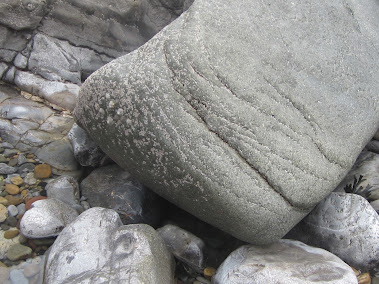Some of the quarried sites featured in the article, exploiting natural rock outcrops very close to the places where monoliths and filler stones were needed.
At last, some decent evidence of magalith stone quarrying in the Late Neolithic! It comes from Huelva in Spain, thanks to Josė Antonio Linares-Catela and his colleagues. It's a very detailed study of the rocks used in the construction of a dolmen complex in Southern Spain, in an area presumably outside the influence of Quaternary glaciation. (There were glaciers in the Sierra Nevada, but not, according to the latest studies, this far west......)
In their Introduction, surveying the European scene regarding Neolithic "quarries", the authors rather too blithely accept that there were quarries at places like Craig Rhosyfelin, Carn Goedog and Vestra Fiold, and they should be chastised for that. But their work relating to the dolmen group is very careful indeed, and is well described. They identify a number of different rock types used in the building of the dolmens, and show that they have all come from the immediate vicinity. The most distant stone sources are about 500 m away, but most came from less than 100 m away from the dolmen sites. Most of the stones were simply collected up from a stone scatter, but some were extracted from adjacent rocky outcrops, just as happened at Callanish.
There is not much in the article about quarrying methods, but the presence of small river-rounded stones from a nearby river gorge are scattered about, and are assumed to have been used for the shaping of crude slabs and elongated pillars for the purposes of creating the dolmens. it seems to have been assumed that the extracted monoliths were simple levered away and collected from rockface situations where they were already loose and accessible. Needless to say, there is no mention anywhere of "soft rock wedges"........
I think this is an important article, showing that Neolithic megalithic sites were often (and maybe always) determined by the availability of convenient stone; that where possible big stones were simply collected up from where they lay; and that quarrying of monoliths was a last resort, used to supplement the supply of stones used "more or less where found".
It was all very utilitarian and pragmatic, with the minimisation of effort clearly uppermost in the minds of the megalith or tomb builders. This article does nothing whatsoever to enhance the fantasies about bluestone quarrying in West Wales; indeed, it demonstates that the quarrying of the bluestones hundreds of km from the place where they were used was vanishingly unlikely.
QUOTE: "As Scarre (2020) noted, the choice of megalithic sites is determined by the presence of large rocky outcrops and abundant blocks scattered on the surface, and at the Los Llanetes group, there is a clear spatial association between the construction sites and the source areas."
=======================
Archaeological and Anthropological Sciences (2023) 15:101
===============
Choosing the site, getting the stones, building the dolmens: local sourcing of andesites at the El Pozuelo megalithic complex (Huelva, Spain)
José Antonio Linares‐Catela· Teodosio Donaire Romero · Coronada Mora Molina · Luis Miguel Cáceres Puro
Abstract
The geoarchaeological study focuses on the lithological characterization and provenance determination of the rocks of the El Pozuelo dolmens. The difficulty of identifying volcanic rocks in the intensely altered and deformed environment of the Iberian Pyrite Belt has required the implementation of a research methodology combining the archaeological and geological analysis of the megaliths and the area surrounding the Los Llanetes group. A total of 29 thin sections and 14 geochemical analyses (ICP-AES, ICP-MS and REE) have been carried out on samples from the dolmens and potential source areas, focusing on the chemical elements considered immobile during alteration processes. The petrological analyses confirm the identification of different andesite lithotypes and enable us to correlate the rocks used in the construction of the megaliths with source areas and quarries located within a 50–350 m radius. Several patterns are observed in the selection of the rocks, based on the material, visual and symbolic properties of the different lithologies. Foliated andesite is the most common stone used in the monuments, due to its excellent physical properties and technological suitability for extraction and transformation into megalithic supports. Other types of andesite (sheared, massive and amphibole-phyric), white quartz, ferruginous agglomer- ate and gabbro were also used for different architectural purposes. The results confirm the importance of locally available suitable rocks in determining site location, raw material procurement and monument construction during the Late Neolithic.















